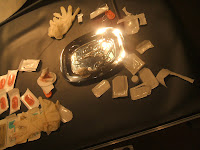 So far, my focus has been art and not performance, so last night I put that right by attending live events scheduled as part of the re.act conference. These might be summed up as blood, clothes and laughter. Quite the gamut of emotions and responses and, indeed, intent, though I can't be sure of the latter.
So far, my focus has been art and not performance, so last night I put that right by attending live events scheduled as part of the re.act conference. These might be summed up as blood, clothes and laughter. Quite the gamut of emotions and responses and, indeed, intent, though I can't be sure of the latter. Boryana Rossa's performance The Vitruvian Body was conducted with the Bulgarian artist wired up with a headset a la Janet Jackson ca. 1990 or, indeed, presenters on the Home Shopping Network. But rather than try and sell an unseen audience a range of rather shoddy consumer goods, she had more pressing concerns. The contrast between her rather matter-of-fact commentary on her ideas about the idealised body and what was actually happening was disquieting. As she spoke, she undressed, positioned herself inside a circular apparatus and then had her arms and legs sewn into it by her colleague Oleg Mavromatti. Much has been spoken about body art and feminist theory in relation to it. But this was the first time I had actually seen a live performance of it.
Rossa created a very striking relationship to the audience. Before she started the performance, she invited people to come as close as they wanted and to take pictures in any form they wanted: mobile phones, cameras, video cameras, etc. She wanted the audience to document and participate in the performance. For that reason, I think the experience was less uncomfortable for me than I might have anticipated. I went up close, I had a good look at the stitching. I saw the blood run down her leg.
I wasn't shocked, but I felt a lot of empathy, as did many other audience members. Once the artist escalated the performance to have her lips sewn shut, as a protest against censorship in the Czech Republic, many flinched, as she was clearly in pain and a lot of blood ran down her chin. But, she had also invited an audience member to cut her free, and that allowed a certain amount of relief: we observed and were complicit in her pain but we could also participate in her liberation. Body art and manipulation are not really my areas of interest but it was certainly an intense experience. I also found it rather endearing that several older artists approached Rossa afterward and hugged her, as if offering comfort as well as congratulations for her performance/ordeal.
The other two performances also involved a certain amount of discomfort, both for the artist and audience, though not in the visceral manner of Rossa's. Tanja Ostojic re-enacted Juniper Perlis's Clothes I, which involved the artist attempting to put on all the clothes she owned during the duration of the performance. This was a curious exercise: firstly, Ostojic was re-enacting quite a modern performance, originally done in 2003; secondly, Perlis apparently spent several hours getting to the venue with her clothing (she said she had to carry her own baggage) and then putting them on, while Ostojic's performance was less than an hour; thirdly, Ostojic came nowhere near to putting on all of the clothing she had arrayed on the stage, as she must have known.
As she put on an item of clothing, Ostojic displayed quite a large grin, as if she were a small child doing something a bit naughty and was testing out the limits of parental patience. Then she would step up to the mic in her bulky clothing and read a bit of text about her own mother's experience in Yugoslavia or about Perlis's experience of homelessness. Again, one sensed quite a bit of audience empathy for the artist, with calls of "Tanja! Don't rip it!", as she attempted to pull on a delicate item. And once she had everything on she could manage, several women, including Rossa, got on-stage to help her extricate herself.
By contrast, the final performance, Antonia Baehr's Lachen, was conducted in a more formal setting, a proscenium theatre, with Baehr reading from a score, taking bows in between scenes, and the audience very much kept at a distance. However, given that the content of Baehr's performance was laughter, this allowed the audience to share in it, in a strange way. Baehr had invited friends and family to compose laughter pieces for her to perform. This was a testing experience and I felt more uncomfortable at certain places than I did in Rossa's performance. Who wants to spend an hour watching someone laugh? But, there was variation and some clever staging, with Baehr dropping balls and laughing in time to them. And the final piece had her performing a duet with herself on a TV monitor, with the TV self giving the live self orders. At the end the artist switched off the TV.
No comments:
Post a Comment